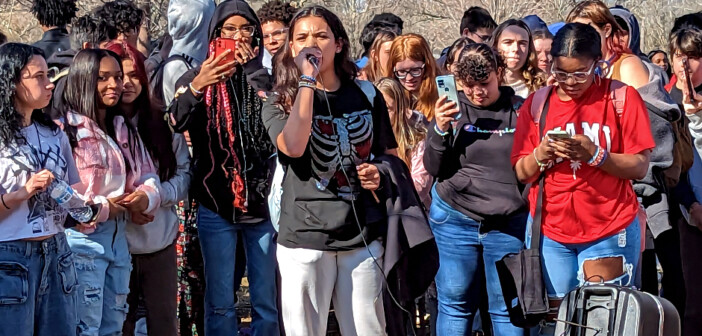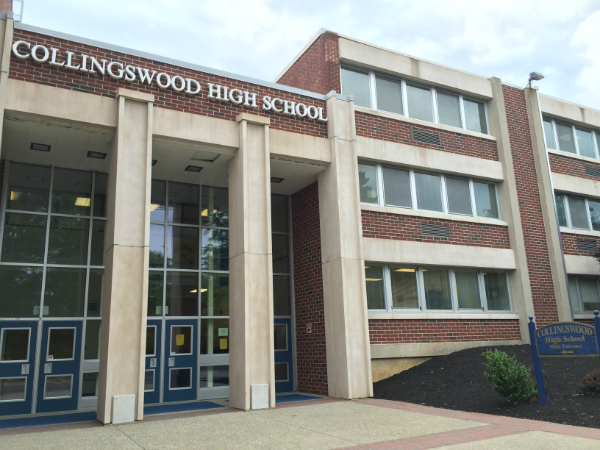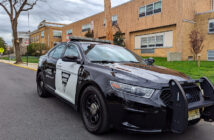Students blame racial bias for what they describe as excessive discipline of their Black and brown peers. District authorities support their freedom of expression and promise to investigate student claims.
By Matt Skoufalos | February 8, 2023
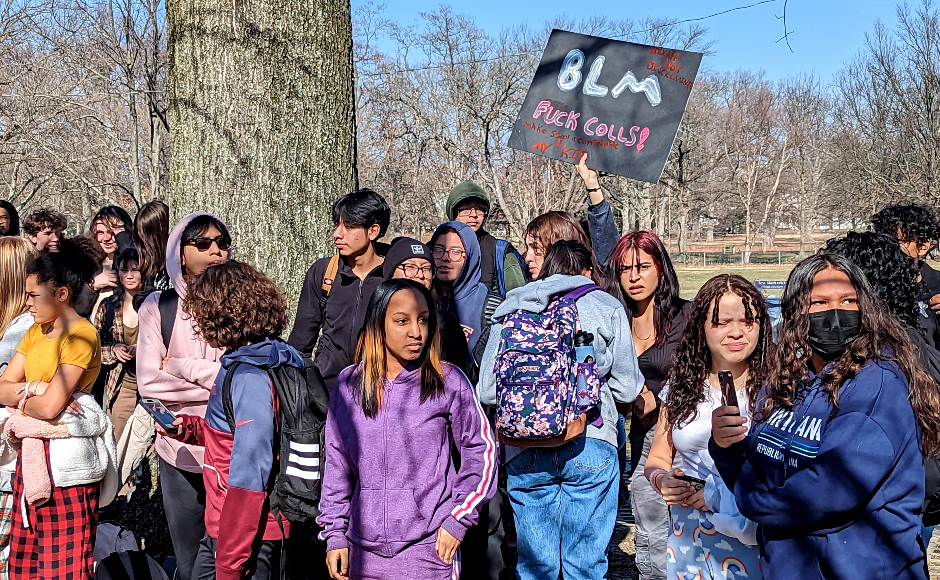
Collingswood High School students staged a walk-out to protest what they described as a climate of bias in the district. Credit: Matt Skoufalos.
Students at Collingswood High School staged a walk-out Wednesday, protesting what they described as racially disparate mistreatment at the hands of some teachers, staff, and administrators in the building.
Availing themselves of a megaphone and amplified sound system provided by Camden City organizer Gary Frazier, a large group of high-schoolers left class in the middle of the day, chanting “Black lives matter,” and calling for the district to take action against adults whom they say have discriminated against them for the color of their skin.
Sophomore Josh Pritchett described his experiences in the school as feeling like he’d been “racially profiled,” and subjected to disproportionate discipline as a Black student.
When he complained of his legs hurting one day, Pritchett said a teacher asked if he was sore because he’d been “running from the cops.” He said another administrator called him and his Black classmates “hoodlums.”
Pritchett’s tenth-grade classmate Kevin Jones said that once, when he was insubordinate to a gym teacher, the encounter escalated to the point where it almost turned physical. Until school security officers came in to restrain the adult, Jones believed it might have gone that way.
“He said, ‘If I have to lose my job today, lose my license, I will,’” the student recalled.
Other high-schoolers spoke about staff using coded language to justify more harshly disciplining Black students, whom they say face more severe consequences than their white counterparts.
“If two white students have a problem with each other, it doesn’t always lead to discipline,” sophomore Mya Fonseca said. “But Black students are told they’re being disruptive, being hostile, need to leave the room, or need to be separated.
“I think it opens everyone’s eyes around us to what’s going on,” Fonseca said. “I would like to see fair treatment.”
Sophomore Isabella Brown said that she and a peer were told they were being disruptive as they chatted together in the guidance office while waiting to see a counselor. Despite another staff member trying to defuse the situation, Brown’s classmate was suspended. She described the encounter as an example of some school staff members “almost provoking some of the students into acting out.
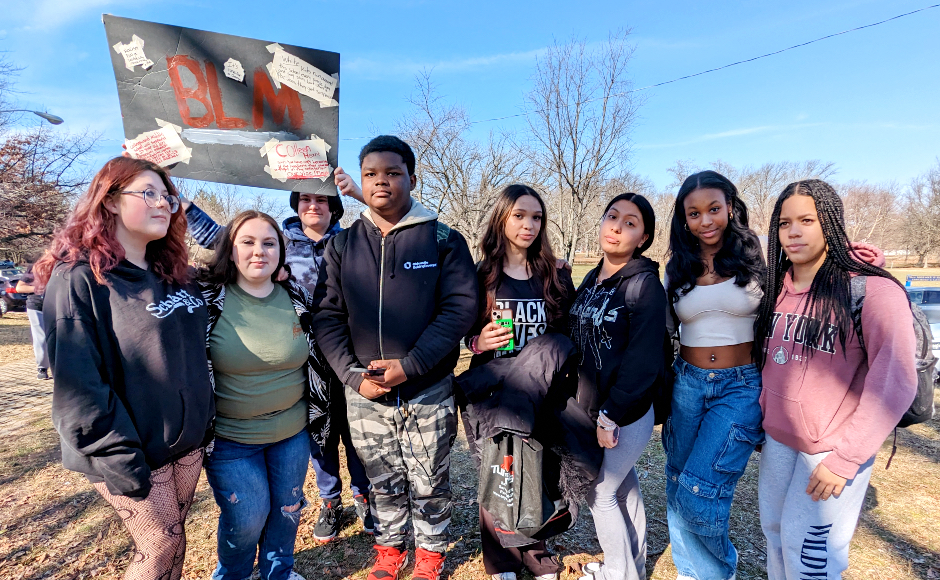
Collingswood High School students protested what they described as a climate of racial bias in the district. Credit: Matt Skoufalos.
“There’s a problem in Collingswood High School, and no matter how diverse we are, there’s still going to be racism from staff,” Brown said. “It’s really sad watching my peers switch schools or go into homeschooling [to leave this environment].”
Freshman Haile Alexander said that messaging from the school was mixed on Wednesday’s walk-out. After the first group of kids left the building, others were prevented by administrators from doing so. He said students were told that those measures were precautionary.
“[They said] ‘We have to ensure your safety; we take racism very seriously,’” Alexander said. “Why do you wait until now, when there’s protests, to say something like that?”
Junior class member Tomas Money, Jr. said that he believes the majority of teachers and staff care about the students, and that CHS is generally a good school. But without the campus coming together and reinforcing expectations, he doesn’t believe things will improve.
“I feel like the staff misunderstands students, and students misunderstand staff,” Money, Jr. said. “Kids need to understand the rules.
“I think everyone has to listen to both sides of the story, and come together for one solution.”
The district and community at large did help set the stage for the CHS student body to demonstrate peacefully. Collingswood Police Chief Kevin Carey said his principal concern was pedestrian safety along Collings Avenue, as students and members of the public congregated on the grass in Knight Park across from the school building.
“We’re here in a supportive role to make sure everyone’s safe,” Carey said. “Protect and serve is what we do, and this is the true principle of that. We want to make sure their voices are heard in a safe manner.”
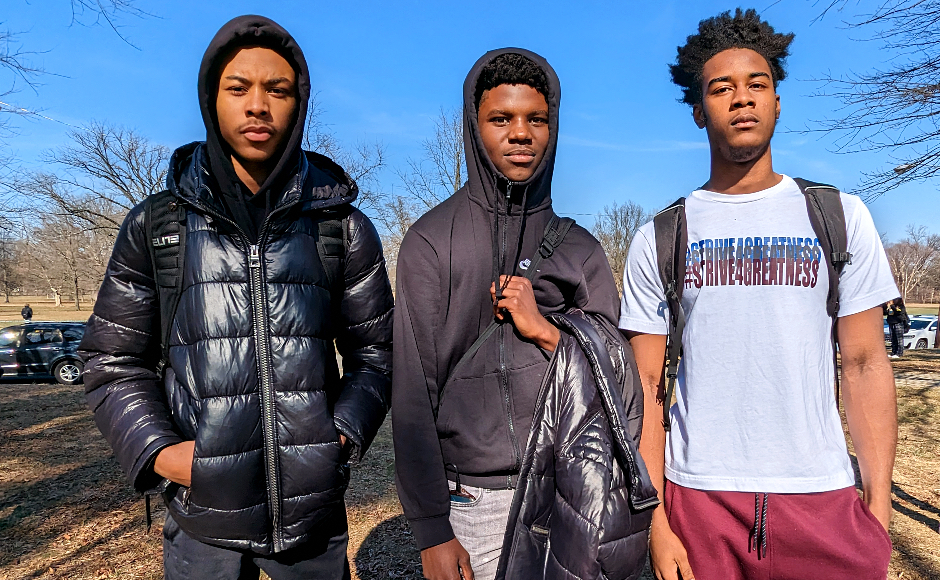
Collingswood High Schooler Tomas Money, Jr. (right) said staff and students misunderstand each other on cultural issues. Credit: Matt Skoufalos.
Collingswood Superintendent of Schools Fredrick McDowell said the district supports students exercising their First Amendment rights to assemble.
He took exception not with their concerns, but with some of the accusations levied, and vowed that the district would investigate.
“You can not like the methods, but don’t reject the message,” McDowell said.
“To me, the message is loud and clear. There are children who believe they are being treated unfairly and it’s up to us to address their concerns. We need to make sure we are not just listening, but acting in the best interests of the students.
“We always have to remember that these are children,” he said. “These are intelligent, articulate children who have expressed their concerns. We’re going to figure out how to provide support to the school to get through this process, but the process has to include students and staff.”
The superintendent said next steps for the district include understanding the specific encounters that students have identified as being racially charged. The specifics of stories like Pritchett’s, James’, or Brown’s were unfamiliar to him, but McDowell said that the district has “a duty to respond” when notified of such incidents.
“We need to have a very clear understanding of what are the concerns being raised,” he said. “A large group of folks yelling into a microphone doesn’t really get us to that. We need to have a formal way to be able to capture what is happening, who it’s happening to, and what are the circumstances around why it happened.
“We need to have further discussions, and that’s what we’re committed to doing,” McDowell said. “It was troubling to me to hear that students believed that racism was being condoned on campus. That is not who we are as an organization. It was troubling to me that students believed that their only way to be heard was to walk out of the school. We have to work together.”
The superintendent acknowledged that “cultural misunderstandings” do occur within the district, “probably on a daily basis.” However, he said, “these cultural challenges did not happen overnight, and they’re not going to be fixed overnight.
“Our responsibility is to make sure that students have a voice, an opportunity to express their concerns, and that faculty and staff have the training to address these issues when they happen,” McDowell said. “The only way that these things happen is for us coming together, and talking through what kind of school environment we want to have, and how are we going to take meaningful steps to get there.”
Collingswood Board of Education President Regan Kaiden said that, although the school board has not yet had an opportunity to analyze demographic data around discipline in the district, the body has asked district professionals to provide that information.
“We have asked our data people to break the suspension information down to a more molecular level so we can see what’s actually happening,” Kaiden said.
“From conversations with Dr. McDowell, the data is looking like there are some concerns at the high school that we need to address.
“Suspensions for ‘disrespect’ or ‘being disorderly’ is so subjective,” she said. “Getting down to what that means is important for consistency. What is disrespectful or disruptive to one person is not for another.”
To Kaiden, conversations throughout the district in the past few weeks have revealed that “a lot of different groups at that high school,” be they students, teachers, or staff are “not feeling as heard and as included as they would like to be in various different ways.”
“There’s a lot of work to be done,” she said. “We are in no way, shape, or form shying away from that.”
Meaningfully addressing those concerns, however, will take time and resources, and the district may have to bring in some outside help to do it.
“You can’t audit your own racism,” Kaiden said. “That has to come from an external source that’s coming in and taking a neutral look at what’s going on here. We can’t put all that on our teachers or administrators, because it’s not going to be effective. We have to meet everybody where they’re at.”
District leaders have promised meaningful changes will follow from Wednesday’s student action, including small-group conversations with students, staff, and others. Kaiden said the full blueprint of what’s to come isn’t known yet, but promised that the district wouldn’t let the issue fester any further.
“This isn’t something that we can just keep kicking the can down the road, and the students are making that extra-clear,” she said. “What’s important is what happens next. You stood up; you made your voice heard. Now come be with us as part of the solution to this problem.
“We need to harness that civic energy they’ve got, and bring them back into the fold to make things better, not only for themselves but the kids that come after,” Kaiden said.
Please support NJ Pen with a subscription. Get e-mails, follow us on Facebook, Twitter, and Instagram, or try our Direct Dispatch text alerts.

